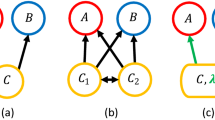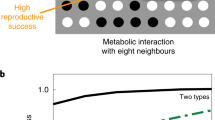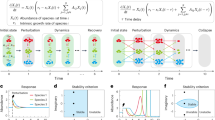Abstract
The dynamics of large ecological systems result from vast numbers of interactions between individual organisms. Here, we develop mathematical theory to show that the rate of such interactions is inherently limited by the ability of organisms to gain information about one another. This phenomenon, which we call ‘information limitation’, is likely to be widespread in real ecological systems and can dictate both the rates of ecological interactions and long-run dynamics of interacting populations. We show how information limitation leads to sigmoid interaction rate functions that can stabilize antagonistic interactions and destabilize mutualistic ones; as a species or type becomes rare, information on its whereabouts also becomes rare, weakening coupling with consumers, pathogens and mutualists. This can facilitate persistence of consumer–resource systems, alter the course of pathogen infections within a host and enhance the rates of oceanic productivity and carbon export. Our findings may shed light on phenomena in many living systems where information drives interactions.
This is a preview of subscription content, access via your institution
Access options
Access Nature and 54 other Nature Portfolio journals
Get Nature+, our best-value online-access subscription
$29.99 / 30 days
cancel any time
Subscribe to this journal
Receive 12 digital issues and online access to articles
$119.00 per year
only $9.92 per issue
Buy this article
- Purchase on Springer Link
- Instant access to full article PDF
Prices may be subject to local taxes which are calculated during checkout






Similar content being viewed by others
Code availability
Simulations and ODE system solutions were conducted in the R environment (R Development Core Team). Code is available for download as Supplementary Software.
References
Nowak, M. A. & Bangham, C. R. Population dynamics of immune responses to persistent viruses. Science 272, 74–79 (1996).
Anderson, R. M. & May, R. M. Infectious Diseases of Humans: Dynamics and Control (Oxford Univ. Press, 1992).
Suweis, S., Grilli, J., Banavar, J. R., Allesina, S. & Maritan, A. Effect of localization on the stability of mutualistic ecological networks. Nature Commun. 6, 10179 (2015).
Levine, J. M., Bascompte, J., Adler, P. B. & Allesina, S. Beyond pairwise mechanisms of species coexistence in complex communities. Nature 546, 56–64 (2017).
Woodson, C. B. & Litvin, S. Y. Ocean fronts drive marine fishery production and biogeochemical cycling. Proc. Natl Acad. Sci. USA 112, 1710–1715 (2015).
Stevens, M. Sensory Ecology, Behaviour, and Evolution (Oxford Univ. Press, 2013).
Hein, A. M., Carrara, F., Brumley, D. R., Stocker, R. & Levin, S. A. Natural search algorithms as a bridge between organisms, evolution, and ecology. Proc. Natl Acad. Sci. USA 113, 9413–9420 (2016).
Torres, L. G. A sense of scale: foraging cetaceans use of scale‐dependent multimodal sensory systems. Mar. Mammal Sci. 33, 1170–1193 (2017).
Hein, A. M., Brumley, D. R., Carrara, F., Stocker, R. & Levin, S. A. Physical limits on bacterial navigation in dynamic environments. J. R. Soc. Interface 13, 20150844 (2016).
Nevitt, G. A. et al. Evidence for olfactory search in wandering albatross, Diomedea exulans. Proc. Natl Acad. Sci. USA 105, 4576–4581 (2008).
Hutchinson, J. M. & Waser, P. M. Use, misuse and extensions of ‘ideal gas’ models of animal encounter. Biol. Rev. 82, 335–359 (2007).
Dusenbery, D. B. Living at Micro Scale: The Unexpected Physics of Being Small (Harvard Univ. Press, 2009).
Gurarie, E. & Ovaskainen, O. Towards a general formalization of encounter rates in ecology. Theor. Ecol. 6, 189–202 (2013).
Hein, A. M. & McKinley, S. A. Sensory information and encounter rates of interacting species. PLoS Comput. Biol. 9, e1003178 (2013).
Redner, S. A Guide to First-Passage Processes (Cambridge Univ. Press, 2001).
Lanoiselée, Y., Moutal, N. & Grebenkov, D. S. Diffusion-limited reactions in dynamic heterogeneous media. Nature Commun. 9, 4398 (2018).
Slessor, K. N., Winston, M. L. & Le Conte, Y. Pheromone communication in the honeybee (Apis mellifera L.). J. Chem. Ecol. 31, 2731–2745 (2005).
McDonald, M. A., Calambokidis, J., Teranishi, A. M. & Hildebrand, J. A. The acoustic calls of blue whales off California with gender data. J. Acoust. Soc. Am. 109, 1728–1735 (2001).
van Breugel, F., Riffell, J., Fairhall, A. & Dickinson, M. H. Mosquitoes use vision to associate odor plumes with thermal targets. Curr. Biol. 25, 2123–2129 (2015).
Lämmermann, T. et al. Neutrophil swarms require LTB4 and integrins at sites of cell death in vivo. Nature 498, 371–375 (2013).
Oaten, A. & Murdoch, W. W. Functional response and stability in predator–prey systems. Am. Nat. 109, 289–298 (1975).
Rosenzweig, M. L. Paradox of enrichment: destabilization of exploitation ecosystems in ecological time. Science 171, 385–387 (1971).
Brose, U., Williams, R. J. & Martinez, N. D. Allometric scaling enhances stability in complex food webs. Ecol. Lett. 9, 1228–1236 (2006).
Bascompte, J., Melián, C. J. & Sala, E. Interaction strength combinations and the overfishing of a marine food web. Proc. Natl Acad. Sci. USA 102, 5443–5447 (2005).
Murdoch, W. W. Switching in general predators: experiments on predator specificity and stability of prey populations. Ecol. Monogr. 39, 335–354 (1969).
Real, L. A. The kinetics of functional response. Am. Nat. 111, 289–300 (1977).
Sarnelle, O. & Wilson, A. E. Type III functional response in Daphnia. Ecology 89, 1723–1732 (2008).
Williams, R. J. & Martinez, N. D. Stabilization of chaotic and non-permanent food-web dynamics. Eur. Phys. J. B 38, 297–303 (2004).
McCauley, E., Nisbet, R. M., Murdoch, W. W., de Roos, A. M. & Gurney, W. S. Large-amplitude cycles of Daphnia and its algal prey in enriched environments. Nature 402, 653–657 (1999).
Antia, R., Koella, J. C. & Perrot, V. Models of the within-host dynamics of persistent mycobacterial infections. Proc. R. Soc. Lond. B 263, 257–263 (1996).
Reddy, R. C. & Standiford, T. J. Effects of sepsis on neutrophil chemotaxis. Curr. Opin. Hematol. 17, 18–24 (2010).
Savoca, M. S. & Nevitt, G. A. Evidence that dimethyl sulfide facilitates a tritrophic mutualism between marine primary producers and top predators. Proc. Natl Acad. Sci. USA 111, 4157–4161 (2014).
Cronin, T. W., Johnsen, S., Marshall, N. J. & Warrant, E. J. Visual Ecology (Princeton Univ. Press, 2014).
Cahil, J. F. & McNickle, G. G. The behavioral ecology of nutrient foraging by plants. Annu. Rev. Ecol. Evol. Syst. 42, 289–311 (2011).
McKenzie, H. W., Lewis, M. A. & Merrill, E. H. First passage time analysis of animal movement and insights into the functional response. Bull. Math. Biol. 71, 107–129 (2009).
Hassell, M. P., Lawton, J. H. & Beddington, J. R. Sigmoid functional responses by invertebrate predators and parasitoids. J. Anim. Ecol. 46, 249–262 (1977).
Bartumeus, F. et al. Foraging success under uncertainty: search tradeoffs and optimal space use. Ecol. Lett. 19, 1299–1313 (2016).
Benhamou, S. Of scales and stationarity in animal movements. Ecol. Lett. 17, 261–272 (2014).
Raposo, E. P. et al. How landscape heterogeneity frames optimal diffusivity in searching processes. PLoS Comput. Biol. 7, e1002233 (2011).
Cooper, W. E. Jr & Blumstein, D. T. Escaping from Predators: An Integrative View (Cambridge Univ. Press, 2015).
Gil, M. A. & Hein, A. M. Social interactions among grazing reef fish drive material flux in a coral reef ecosystem. Proc. Natl Acad. Sci. USA 114, 4703–4708 (2017).
Berg, H. C. & Purcell, E. M. Physics of chemoreception. Biophys. J. 20, 193–219 (1977).
Fenton, A. & Perkins, S. E. Applying predator–prey theory to modelling immune-mediated, within-host interspecific parasite interactions. Parasitology 137, 1027–1038 (2010).
Chtanova, T. et al. Dynamics of neutrophil migration in lymph nodes during infection. Immunity 29, 487–496 (2008).
Vandermeer, J. H. & Boucher, D. H. Varieties of mutualistic interaction in population models. J. Theor. Biol. 74, 549–558 (1978).
Goh, B. S. Stability in models of mutualism. Am. Nat. 113, 261–275 (1979).
Holland, J. N., DeAngelis, D. L. & Bronstein, J. L. Population dynamics and mutualism: functional responses of benefits and costs. Am. Nat. 159, 231–244 (2002).
Benoit-Bird, K. J., Waluk, C. M. & Ryan, J. P. Forage species swarm in response to coastal upwelling. Geophys. Res. Lett. 46, 1537–1546 (2019).
Kahru, M., Di Lorenzo, E., Manzano-Sarabia, M. & Mitchell, B. G. Spatial and temporal statistics of sea surface temperature and chlorophyll fronts in the California Current. J. Plankton Res. 34, 749–760 (2012).
de Roos, A. M. & Persson, L. Population and Community Ecology of Ontogenetic Development (Princeton Univ. Press, 2013).
Jensen, F. H., Johnson, M., Ladegaard, M., Wisniewska, D. M. & Madsen, P. T. Narrow acoustic field of view drives frequency scaling in toothed whale biosonar. Curr. Biol. 28, 3878–3885 (2018).
Marten, K. & Marler, P. Sound transmission and its significance for animal vocalization. Behav. Ecol. Sociobiol. 2, 271–290 (1977).
Vergassola, M., Villermaux, E. & Shraiman, B. I. ‘Infotaxis’ as a strategy for searching without gradients. Nature 445, 406–409 (2007).
Ward, S. Chemotaxis by the nematode Caenorhabditis elegans: identification of attractants and analysis of the response by use of mutants. Proc. Natl Acad. Sci. USA 70, 817–821 (1973).
Dekker, T. & Cardé, R. T. Moment-to-moment flight manoeuvres of the female yellow fever mosquito (Aedes aegypti L.) in response to plumes of carbon dioxide and human skin odour. J. Exp. Biol. 214, 3480–3494 (2011).
Riffell, J. A. et al. Flower discrimination by pollinators in a dynamic chemical environment. Science 344, 1515–1518 (2014).
Acknowledgements
We thank members of the Information in Ecology Workshop held at UBC, S. Munch, S. McKinley, R. Nisbet, M. O’Connor, D. Brumley, F. Carrara, S. Redner and M. Gil, for comments and suggestions. A.M.H. and B.T.M. were supported by NSF IOS grant no. 1855956. A.M.H. acknowledges Simons Foundation grant no. 395890.
Author information
Authors and Affiliations
Contributions
A.M.H. and B.T.M. designed the study, performed analyses and wrote the paper.
Corresponding author
Ethics declarations
Competing interests
The authors declare no competing interests.
Additional information
Publisher’s note Springer Nature remains neutral with regard to jurisdictional claims in published maps and institutional affiliations.
Extended data
Extended Data Fig. 1 Shape of interaction rate functions is preserved under continuous variation in the degree of directed motion.
(a) Rate of drift toward target as a function of distance from the target for the two-state model described in the main text with l*=100 body lengths (black line), and for three alternative models in which drift rate toward the target is a saturating function of a signal that decays exponentially (purple), like a Gaussian (orange) or like an inverse-square power law (green) with distance from the target. Signal decay parameters were chosen so that the mean drift speed at distance 100 body lengths are equal for all models. Drift rate, H(l), is calculated as a saturating function of the signal to constrain searchers to a maximum drift speed: H(l)=−vmaxtanh(S(l)), where S(l) is the signal value at a distance l, from a target (see Supplementary Discussion for details). The hyperbolic tangent form is motivated by past work on signal-dependent taxis responses15,16; other saturating functions yield similar results. (b) Interaction rate computed by solving Eq. (1) using the drift rates shown in panel (a). (c) Per-capita interaction rates corresponding to interaction rates shown in panel (b). Note non-monotonic form similar to that shown in Fig. 2c of the Main Text. (d) Range of drift functions with different parameter values. Each curve is one parameterization of the exponential signal function shown in panel (b) with drift rate again given by H(l)=−vmaxtanh(S(l)). Dark colored curves indicate functions in which change in drift rate with distance from target is relatively slow, whereas lighter colors are drift rate functions with more abrupt transition from high to low drift rate as distance from target increases. (e) Per-capita encounter rate as a function of target density for the same curves shown in panel (d). Note that location and height of peak changes but qualitative shape of curve is preserved.
Extended Data Fig. 2 Interaction rates in random target landscapes.
(a) Interaction rate and per-capita interaction rate in a two-dimensional landscape with targets distributed according to a Poisson spatial process, (b) targets distributed according to a Poisson spatial process in which the length scale of sensory information, l*, differs for each target, and (c) targets distributed according to a Poisson spatial process where the searcher depletes targets as it moves through the environment. Points correspond to l* of 5 (squares), 10 (boxes), 20 (triangles), and 40 (diamonds) body lengths. For the simulation with variable l*, these values are averages. See Supplementary Discussion ‘Robustness to spatial arrangement, target variability, and target depletion’ for a description of simulations.
Extended Data Fig. 3 Analytic approximation of interaction rates in a random target landscape.
Per-capita interaction rates in a two-dimensional landscape with targets distributed according to a Poisson spatial process. Lines show analytic approximation (see Supplementary Discussion ‘Analytic approximation for interaction rate in a random target field’). Note that, while approximation overestimates per-capita rate at intermediate density, prediction at high and low densities is accurate, as is the predicted location of peak per-capita interaction rate.
Supplementary information
Supplementary Information
Supplementary discussion of analyses and additional supporting results as well as tables.
Rights and permissions
About this article
Cite this article
Hein, A.M., Martin, B.T. Information limitation and the dynamics of coupled ecological systems. Nat Ecol Evol 4, 82–90 (2020). https://doi.org/10.1038/s41559-019-1008-x
Received:
Accepted:
Published:
Issue Date:
DOI: https://doi.org/10.1038/s41559-019-1008-x
This article is cited by
-
The ecological roles of bacterial chemotaxis
Nature Reviews Microbiology (2022)
-
The scent of fear makes sea urchins go ballistic
Movement Ecology (2021)
-
Beyond an ecological ideal gas law
Nature Ecology & Evolution (2019)



